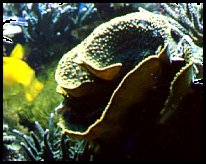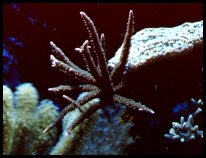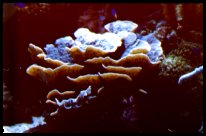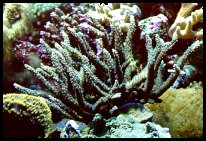| The
past few years stone corals with small polyps from the genus Acropora,
Montipora, Pocillopora,en Seriatopora receive more and more
attention of the owners of reefaquaria. Less frequent specimen from the family
of the Pectiniidae in which the genera Mycelium, Echinophyllia,
Oxypora, Physophyllia and Pectinia belong are me , which
without doubt will be connected with the larger depth from where the organisms
originate. To identify them is rather difficult question, because, excepting the
Pectinia, that never has a discoid appearance, the animals strongly resemble each
other in their tin palle like growth.
Feeding :
1.
Symbiotic alga(zoöxanthells) This live in the (inner one of the two
body walls). Their number may vary, depending on the strength of lighting, from
100.000/cm till 10.000.000/cm2 and depends of the species
of the corals and the intensity of the lighting. Between the zoöanthells
and the animal tissue of the host there is a flow of material and energy. These
complete each other on perfect way. Photosynthesis and breathing have been liaised
on the level of the cells, by wich these flows can take place practically without
loss.
2.Endolitic alga.In addition to the zo÷xanthells stony corals
have a second photo-autotrophe source of food. In the skeleton of quite a lot
of species with an without zoöxanthells as well live red and green alga Between
this drilalga and the coral skeletons there is taking place |
an exchanging
of substances that can be compared with the exchange as is described above.
3
All sorts off particles of food coming from outside. The supply of this nutrients
on the reef is abundant and encloses bacteria, larger zo÷plankton and particles
of
vegetable origin and of animal origin
in the most divers sizes as well.
................Depending
on the depth the supply of this changes in qualitative and quantitative way; In
the upper layer of water takes place the primary production of the plankton, by
what a larger supply of zo÷plankton is involved. The more the depth increases
and the intensity of light decreases the importance of 1 and 2 will decrease and
that of 3 will increase.
Here we often see tentacle lesss corals with a discoid shape at which the mouth
opening(s) are at the upper side. The transport of the received food takes place
than with the aid of the ceilia (a kind of flagellum's ) that make, often through
grooves, "stream" the food to the mouth opening It concern particles
of food that are not of any interest for the predators because it takes to much
energy to capture them in sufficient number and that sink down therefor. With
other corals that don't have Celia where distinct grooves are lacking, the particles
are instantaneous wrapped up in slime and transported to the moth opening (Mycedium
elephantotus)
Who wants to know more about
the extreme interesting way of life can read more about it in Datz 1999 no 10,
11 en 12 en 2000 en Aquaristiek Fachmagasinvan de Tetra Werke jaargang 33 no 1 |



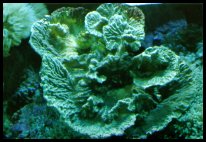
![]() Pectinia
spec...
Pectinia
spec...
![]() Acropora albrolhosensis
Acropora albrolhosensis
![]() .Echinopora
lamellosa
.Echinopora
lamellosa ![]()
![]()
